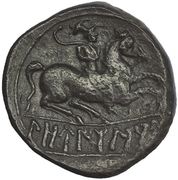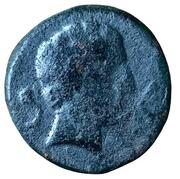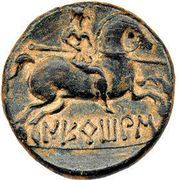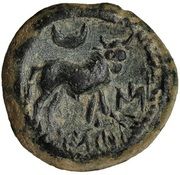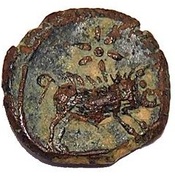Предметы Иберия (древняя)
Do you want to take a photo with the camera or select an existing image?
(en) The Iberian peninsula has long been inhabited, before the Roman conquest. During the 1st millennium BC, in the Bronze Age, the first wave of migrations into Iberia of speakers of Indo-European languages occurred. These were later (7th and 5th centuries BC) followed by others that can be identified as Celts. Eventually urban cultures developed in southern Iberia, such as Tartessos, influenced by the Phoenician colonization of coastal Mediterranean Iberia, with strong competition from the Greek colonization. These two processes defined Iberia's cultural landscape – Mediterranean towards the southeast and Continental in the northwest. The Celtiberians were a group of Celts and Celticized peoples inhabiting the central-eastern Iberian Peninsula during the final centuries BC. These tribes spoke the Celtiberian language and wrote it by adapting the Iberian alphabet, in the form of the Celtiberian script. In 195 BC, part of Celtiberia was conquered by the Romans, and by 72 BC the entire region had become part of the Roman province of Hispania Citerior. The subjugated Celtiberians waged a protracted struggle against the Roman conquerors, staging uprisings in 195-193, 181-179, 153-151, and 143-133. In 105 BC, Celtiberian warriors drove the Germanic Cimbri from Spain in the Cimbrian War (113–101 BC) and also played an important role in the Sertorian War (80–72 BC). The history of ancient Iberian coinage begins as early as the fifth century BC, but widespread minting and circulation in the Iberian peninsula did not begin until late in the third century, during the Second Punic War. Civic coinages - emissions made by individual cities at their own volition - continued under the first two and a half centuries of Roman control until ending in the mid-first century AD. Some non-civic coins were minted on behalf of Roman emperors during this period and continued to be minted after the cessation of the civic coinages. After the cessation of the civic coinages, these Imperial coins were the only coins minted in Iberia until the coins of the Suebi and Visigoths. Ancient Iberia was connected to the eastern and central Mediterranean, and so there are links to the Greek, Roman and Punic (Carthaginian) civic coinages. Yet there are also many points of difference that reflect dynamics within Iberia itself.
- Celtiberia › Arevaci people › Arekorata, City of
- Celtiberia › Arevaci people › Arkailikos gens
- Celtiberia › Arevaci people › Borneskon
- Celtiberia › Arevaci people › Kaisesa
- Celtiberia › Arevaci people › Kolounioku, City of
- Celtiberia › Arevaci people › Louitiskos
- Celtiberia › Arevaci people › Lutia, City of
- Celtiberia › Arevaci people › Sekobirikes
- Celtiberia › Arevaci people › Sekotias Lakas
- Celtiberia › Arevaci people › Teitiakos gens
- Celtiberia › Arevaci people › Uxama Argaela, City of
- Celtiberia › Belli people › Belaiskom
- Celtiberia › Belli people › Bilbilis, City of
- Celtiberia › Belli people › Konterbia Belaiska, City of
- Celtiberia › Belli people › Sekaisa, City of
- Celtiberia › Lusones people › Aratis, City of
- Celtiberia › Lusones people › Bursau
- Celtiberia › Lusones people › Karaues
- Celtiberia › Lusones people › Nertobis
- Celtiberia › Lusones people › Samala
- Celtiberia › Lusones people › Turiasu, City of
- Celtiberia › Pellendones people › Ekualakos
- Celtiberia › Pellendones people › Okalakom
- Celtiberia › Pellendones people › Roturkon
- Celtiberia › Pellendones people › Sekisanos
- Celtiberia › Pellendones people › Tabaniu, City of
- Celtiberia › Pellendones people › Uarkas
- Celtiberia › Titii people › Titum
- Eastern Hispania Ulterior › Bastetani people › Ilturir, City of
- Eastern Hispania Ulterior › Bastetani people › Urkesken gens
- Eastern Hispania Ulterior › Oretani people › Iltiraka
- Eastern Hispania Ulterior › Oretani people › Kastilo, City of
- Eastern Hispania Ulterior › Oretani people › Labini
- Eastern Hispania Ulterior › Oretani people › Sisapo, City of
- Eastern Iberia › Edetani people › Arse-Saguntum, City of
- Eastern Iberia › Edetani people › Basti
- Eastern Iberia › Edetani people › Kelin, City of
- Eastern Iberia › Edetani people › Kili
- Eastern Iberia › Edetani people › Saiti, City of
- Eastern Iberia › Edetani people › Valentia, City of
- Eastern Iberia › Ilercavones people › Abariltur
- Lusitania › Celtici people › Brutobriga, City of
- Lusitania › Celtici people › Dipo, City of
- Lusitania › Turduli people › Baelo Claudia, City of
- Lusitania › Turduli people › Corduba, City of
- Lusitania › Turduli people › Ilurco
- Lusitania › Turduli people › Lacipo
- Lusitania › Turduli people › Serpa, City of
- Lusitania › Turduli people › Sisipo
- Lusitania › Turduli people › Tamusiens
- Lusitania › Turduli people › Ulia, City of
- Meseta Plateau › Carpetani people › Ikesankom Konbouto
- Meseta Plateau › Carpetani people › Konterbia Karbika, City of
- Meseta Plateau › Carpetani people › Toletum
- Meseta Plateau › Olcades people › Erkauika, City of
- Meseta Plateau › Olcades people › Ikalkusken
- Meseta Plateau › Vaccaei people › Segovia, City of
- Meseta Plateau › Vettones people › Tanusia, City of
- Middle Ebro › Ausetani people › Ausesken gens
- Middle Ebro › Ausetani people › Eustibaikula
- Middle Ebro › Ausetani people › Ore, City of
- Middle Ebro › Cessetani people
- Middle Ebro › Cessetani people › Kaio
- Middle Ebro › Cessetani people › Masonsa
- Middle Ebro › Ilergetes people › Arketurki
- Middle Ebro › Ilergetes people › Eso
- Middle Ebro › Ilergetes people › Iltirta
- Middle Ebro › Ilergetes people › Usekerte
- Middle Ebro › Indigetes people › Untikesken gens
- Middle Ebro › Laietani people › Baitolo, City of
- Middle Ebro › Laietani people › Ieso, City of
- Middle Ebro › Laietani people › Iltirkesken gens
- Middle Ebro › Laietani people › Ilturo
- Middle Ebro › Laietani people › Laiesken
- Middle Ebro › Laietani people › Lauro
- Middle Ebro › Laietani people › Oskumken
- Northern Iberia › Berones people › Kaiskata
- Northern Iberia › Berones people › Kalakorikos
- Northern Iberia › Berones people › Karalus
- Northern Iberia › Berones people › Kueliokos
- Northern Iberia › Berones people › Letaisama
- Northern Iberia › Berones people › Metuainum
- Northern Iberia › Berones people › Oilaunikos gens
- Northern Iberia › Berones people › Olkairun
- Northern Iberia › Berones people › Titiakos gens
- Northern Iberia › Berones people › Uarakos gens
- Northern Iberia › Berones people › Uirouia, City of
- Northern Iberia › Vascones people › Arsakoson
- Northern Iberia › Vascones people › Arsaos
- Northern Iberia › Vascones people › Baskunes gens
- Northern Iberia › Vascones people › Bentian
- Northern Iberia › Vascones people › Ontikes gens
- Northern Iberia › Vascones people › Tirsos
- Northern Iberia › Vascones people › Umanbaate
- Peninsular Northeast › Lobetani people › Orosi
- Peninsular Northeast › Sedetani people › Alaun, City of
- Peninsular Northeast › Sedetani people › Iltukoite
- Peninsular Northeast › Sedetani people › Kelse, City of
- Peninsular Northeast › Sedetani people › Lakine
- Peninsular Northeast › Sedetani people › Otobesken gens
- Peninsular Northeast › Sedetani people › Saltuie, Oppidum of
- Peninsular Northeast › Sedetani people › Seteisken gens
- Peninsular Northeast › Sedetani people › Terkakom
- Peninsular Northeast › Suessetani people › Belikio
- Peninsular Northeast › Suessetani people › Bolskan, City of
- Peninsular Northeast › Suessetani people › Iaka, City of
- Peninsular Northeast › Suessetani people › Osca, City of
- Peninsular Northeast › Suessetani people › Sekia
- Peninsular Northeast › Suessetani people › Sesars
- Peninsular Northeast › Turboletae people › Tamaniu
- Western Hispania Ulterior › Cilbiceni people › Baicipo
- Western Hispania Ulterior › Cunetes › Ipses
- Western Hispania Ulterior › Cunetes › Osonuba
- Western Hispania Ulterior › Tartessii people › Baesuri gens
- Western Hispania Ulterior › Tartessii people › Ilse
- Western Hispania Ulterior › Tartessii people › Lastigi
- Western Hispania Ulterior › Tartessii people › Onuba, City of
- Western Hispania Ulterior › Tartessii people › Ostur
- Western Hispania Ulterior › Turdetani people › Abra
- Western Hispania Ulterior › Turdetani people › Acinipo, City of
- Western Hispania Ulterior › Turdetani people › Aipora
- Western Hispania Ulterior › Turdetani people › Balsa, City of
- Western Hispania Ulterior › Turdetani people › Bora
- Western Hispania Ulterior › Turdetani people › Callet
- Western Hispania Ulterior › Turdetani people › Carbula
- Western Hispania Ulterior › Turdetani people › Carisa, City of
- Western Hispania Ulterior › Turdetani people › Carmo, City of
- Western Hispania Ulterior › Turdetani people › Caura
- Western Hispania Ulterior › Turdetani people › Celtitan
- Western Hispania Ulterior › Turdetani people › Cerit
- Western Hispania Ulterior › Turdetani people › Cunbaria
- Western Hispania Ulterior › Turdetani people › Ilipense
- Western Hispania Ulterior › Turdetani people › Ilipla
- Western Hispania Ulterior › Turdetani people › Ilipula Laus
- Western Hispania Ulterior › Turdetani people › Iliturgi
- Western Hispania Ulterior › Turdetani people › Ipora
- Western Hispania Ulterior › Turdetani people › Laelia
- Western Hispania Ulterior › Turdetani people › Murtilis
- Western Hispania Ulterior › Turdetani people › Nabrisa
- Western Hispania Ulterior › Turdetani people › Obulco
- Western Hispania Ulterior › Turdetani people › Orippo, City of
- Western Hispania Ulterior › Turdetani people › Pax Julia, City of
- Western Hispania Ulterior › Turdetani people › Salpesa
- Western Hispania Ulterior › Turdetani people › Searo
- Western Hispania Ulterior › Turdetani people › Ugia, City of
- Western Hispania Ulterior › Turdetani people › Ursone, City of
- Western Hispania Ulterior › Turdetani people › Ventipo
Иберия (древняя) › Celtiberia › Arevaci people › Arekorata, City of • Unit (158-133 BC)
(150 BC - 120 BC)
Монеты › Стандартные монеты обращения
Бронза • 11.2 g
ACIP# 1751, CNH# 272, GCV# 35, Heiss# 7, N# 336464
(125 BC - 101 BC)
Монеты › Стандартные монеты обращения
Бронза • 9 g • ⌀ 23 mm
ACIP# 1777, FAB# 116, CNH# 29, N# 327941
Иберия (древняя) › Celtiberia › Arevaci people › Arekorata, City of • Denarius (late 2nd century BC)
1 Denarius = 2 Quinarii = 10 Asses • 1 As = 2 Semisses = 4 Quadrantes = 6 Sextantes
(125 BC - 101 BC)
Монеты › Стандартные монеты обращения
Бронза • 6.6 g • ⌀ 21 mm
ACIP# 1781, N# 314216
(132 BC - 101 BC)
Монеты › Стандартные монеты обращения
Серебро • 3.94 g
ACIP# 1773, Heiss# 1, CNH# 26, GCV# 34, N# 336335
Иберия (древняя) › Celtiberia › Arevaci people › Arkailikos gens • Unit (last third of the 2nd century BC)
(133 BC - 101 BC)
Монеты › Стандартные монеты обращения
Бронза • 11 g • ⌀ 25 mm
ACIP# 1810, CNH# 1, N# 316426
Иберия (древняя) › Celtiberia › Arevaci people › Borneskon • Unit (late 2nd century BC)
(125 BC - 101 BC)
Монеты › Стандартные монеты обращения
Бронза • 9.8 g • ⌀ 25 mm
ACIP# 1586, CNH# 3, N# 316423
Иберия (древняя) › Celtiberia › Arevaci people › Kaisesa • Unit (second half of the 2nd century BC)
1 Denarius = 2 Quinarii = 10 Asses • 1 As = 2 Semisses = 4 Quadrantes = 6 Sextantes
(150 BC - 101 BC)
Монеты › Стандартные монеты обращения
Бронза • 11.5 g • ⌀ 24.5 mm
ACIP# 1819, CNH# 1, N# 316421
Иберия (древняя) › Celtiberia › Arevaci people › Kolounioku, City of • Denarius (1st century BC)
1 Denarius = 2 Quinarii = 10 Asses • 1 As = 2 Semisses = 4 Quadrantes = 6 Sextantes
(100 BC - 1 BC)
Монеты › Стандартные монеты обращения
Бронза • 12.6 g • ⌀ 26.5 mm
ACIP# 1825, CNH# 3, N# 316418
Иберия (древняя) › Celtiberia › Arevaci people › Louitiskos • Unit (mid 2nd century BC)
(166 BC - 134 BC)
Монеты › Стандартные монеты обращения
Бронза • 14.5 g • ⌀ 27.5 mm
ACIP# 1787, CNH# 1, N# 316416
Иберия (древняя) › Celtiberia › Arevaci people › Lutia, City of • Unit (early 1st century BC)
(100 BC - 76 BC)
Монеты › Стандартные монеты обращения
Бронза • 8.3 g • ⌀ 22 mm
ACIP# 1600, CNH# 1, N# 316440
Иберия (древняя) › Celtiberia › Arevaci people › Sekobirikes • Denarius (late 2nd and early 1st century BC)
1 Denarius = 2 Quinarii = 10 Asses • 1 As = 2 Semisses = 4 Quadrantes = 6 Sextantes
(133 BC - 76 BC)
Монеты › Стандартные монеты обращения
Бронза • 10 g • ⌀ 25 mm
ACIP# 1876, CNH# 1, LV# 1, FAB# 2176, Heiss# 4, N# 82540
(110 BC - 80 BC)
Монеты › Стандартные монеты обращения
Серебро • 3.53 g • ⌀ 19 mm
CNH# 292/9, ACIP# 1873, N# 382203
(110 BC - 80 BC)
Монеты › Стандартные монеты обращения
Серебро • 3.96 g
ACIP# 1869, CNH# 5 p.292, GCV# 38, Heiss# 1, N# 336578
Иберия (древняя) › Celtiberia › Arevaci people › Sekotias Lakas • Unit (last third of the 2nd century BC)
(133 BC - 101 BC)
Монеты › Стандартные монеты обращения
Бронза • 10.7 g • ⌀ 25.5 mm
ACIP# 1880, CNH# 1, N# 316415
Иберия (древняя) › Celtiberia › Arevaci people › Teitiakos gens • Unit (early 1st century BC)
(100 BC - 76 BC)
Монеты › Стандартные монеты обращения
Бронза • 7.9 g • ⌀ 22 mm
ACIP# 1886, CNH# 3, N# 316412
Иберия (древняя) › Celtiberia › Arevaci people › Uxama Argaela, City of • Unit (second half of the 2nd century BC)
(150 BC - 101 BC)
Монеты › Стандартные монеты обращения
Бронза • 9.4 g • ⌀ 22 mm
ACIP# 1929, CNH# 4, N# 316305
Иберия (древняя) › Celtiberia › Belli people › Belaiskom • Unit (late 2nd century BC)
(125 BC - 101 BC)
Монеты › Стандартные монеты обращения
Бронза • 9.2 g • ⌀ 23.5 mm
ACIP# 1814, CNH# 1, N# 314213
Иберия (древняя) › Celtiberia › Belli people › Bilbilis, City of • As (late 2nd and early 1st centuries BC)
1 As = 2 Semisses = 4 Quadrantes
(125 BC - 76 BC)
Монеты › Стандартные монеты обращения
Бронза • 12.1 g • ⌀ 27.5 mm
ACIP# 1574, Heiss# 4, FAB# 258, GCV# 36, N# 294995
Иберия (древняя) › Celtiberia › Belli people › Konterbia Belaiska, City of • Unit (early 1st century BC)
(100 BC - 76 BC)
Монеты › Стандартные монеты обращения
Бронза • 8.8 g • ⌀ 22.5 mm
ACIP# 1595, CNH# 2, N# 316429
Иберия (древняя) › Celtiberia › Belli people › Sekaisa, City of • Unit (late 2nd and early 1st century BC)
(100 BC - 51 BC)
Монеты › Стандартные монеты обращения
Бронза • 8.6 g • ⌀ 23 mm
CNH# 39, N# 362298
(100 BC - 51 BC)
Монеты › Стандартные монеты обращения
Бронза • 8.7 g • ⌀ 23 mm
ACIP# 1560, CNH# 40, FAB# 2131, N# 296958
Иберия (древняя) › Celtiberia › Lusones people › Aratis, City of • Unit (late 2nd century BC)
(125 BC - 101 BC)
Монеты › Стандартные монеты обращения
Бронза • 9.2 g • ⌀ 22.5 mm
ACIP# 1805, CNH# 1, N# 314212
Иберия (древняя) › Celtiberia › Lusones people › Bursau • Unit (late 2nd century BC)
(125 BC - 101 BC)
Монеты › Стандартные монеты обращения
Бронза • 10.6 g • ⌀ 14 mm
ACIP# 1591, CNH# 4, N# 316442
Иберия (древняя) › Celtiberia › Lusones people › Karaues • Unit (second half of the 2nd century BC)
(150 BC - 101 BC)
Монеты › Стандартные монеты обращения
Бронза • 10.2 g • ⌀ 25 mm
ACIP# 1821, CNH# 1, N# 316441
Иберия (древняя) › Celtiberia › Lusones people › Nertobis • Unit (late 2nd century BC)
(125 BC - 101 BC)
Монеты › Стандартные монеты обращения
Бронза • 9.4 g • ⌀ 23.5 mm
ACIP# 1602, CNH# 2, N# 316439
Иберия (древняя) › Celtiberia › Lusones people › Samala • Unit (early 1st century BC)
(100 BC - 76 BC)
Монеты › Стандартные монеты обращения
Бронза • 8.3 g • ⌀ 23.5 mm
ACIP# 1866, CNH# 1, N# 316432
Иберия (древняя) › Celtiberia › Lusones people › Turiasu, City of • Unit (mid second half of the 2nd century BC)
(120 BC - 20 BC)
Монеты › Стандартные монеты обращения
Бронза • 12.52 g • ⌀ 25 mm
ACIP# 1708, Heiss# 4, FAB# 2424, GCV# 31, N# 335830
Иберия (древняя) › Celtiberia › Lusones people › Turiasu, City of • Denarius (second half of the 2nd century BC)
1 Denarius = 2 Quinarii = 10 Asses • 1 As = 2 Semisses = 4 Quadrantes = 6 Sextantes
(125 BC - 101 BC)
Монеты › Стандартные монеты обращения
Серебро • 3.9 g • ⌀ 18 mm
ACIP# 1718, CNH# 17, FAB# 2416, GCV# 30, Heiss# 3, N# 154422
Иберия (древняя) › Celtiberia › Pellendones people › Ekualakos • Unit (second half of the 2nd century BC)
(150 BC - 101 BC)
Монеты › Стандартные монеты обращения
Бронза • 11.6 g • ⌀ 24.5 mm
ACIP# 1846, CNH# 2, N# 314204
Иберия (древняя) › Celtiberia › Pellendones people › Okalakom • Unit (early 1st century BC)
(100 BC - 76 BC)
Монеты › Стандартные монеты обращения
Бронза • 8.1 g • ⌀ 22.5 mm
ACIP# 1863, CNH# 1, N# 316448
Иберия (древняя) › Celtiberia › Pellendones people › Roturkon • Unit (early 1st century BC)
(100 BC - 76 BC)
Монеты › Стандартные монеты обращения
Бронза • 9.0 g • ⌀ 23.5 mm
ACIP# 1868, CNH# 1, N# 316446
Иберия (древняя) › Celtiberia › Pellendones people › Sekisanos • Unit (early 1st century BC)
(100 BC - 76 BC)
Монеты › Стандартные монеты обращения
Бронза • 9.1 g • ⌀ 22.5 mm
ACIP# 1868, CNH# 1, N# 316445
Иберия (древняя) › Celtiberia › Pellendones people › Tabaniu, City of • Unit (second half of the 2nd century BC)
(150 BC - 101 BC)
Монеты › Стандартные монеты обращения
Бронза • 10.2 g • ⌀ 25.5 mm
ACIP# 1605, CNH# 1, N# 316444
Иберия (древняя) › Celtiberia › Pellendones people › Uarkas • Unit (early 2nd century BC)
(200 BC - 176 BC)
Монеты › Стандартные монеты обращения
Бронза • 8.9 g • ⌀ 23.5 mm
ACIP# 1916, CNH# 1, N# 316443
Иберия (древняя) › Celtiberia › Titii people › Titum • Unit (early 1st century BC)
(100 BC - 76 BC)
Монеты › Стандартные монеты обращения
Бронза • 9.2 g • ⌀ 22.5 mm
ACIP# 1900, CNH# 1, N# 314211
Иберия (древняя) › Eastern Hispania Ulterior › Bastetani people › Ilturir, City of • As (mid 2nd century BC)
1 As = 2 Semisses = 3 Trientes = 4 Quadrantes = 6 sextantes
(72-40)
Монеты › Стандартные монеты обращения
Бронза • 12 g • ⌀ 24 mm
ACIP# 2300, FAB# 1503, CNH# 358/14, Vives# 73/9, N# 431110
(175 BC - 126 BC)
Монеты › Стандартные монеты обращения
Бронза • 57.6 g • ⌀ 33 mm
ACIP# 2284, CNH# 1, N# 314601
Иберия (древняя) › Eastern Hispania Ulterior › Bastetani people › Urkesken gens • As (second half of the 2nd century BC)
1 As = 2 Semisses = 3 Trientes = 4 Quadrantes = 6 sextantes
(150 BC - 101 BC)
Монеты › Стандартные монеты обращения
Бронза • 12.9 g • ⌀ 25.5 mm
ACIP# 2102, CNH# 1, N# 314284
Иберия (древняя) › Eastern Hispania Ulterior › Oretani people › Iltiraka • As (second half of the 2nd century BC)
1 As = 2 Semisses = 3 Trientes = 4 Quadrantes = 6 sextantes
(150 BC - 101 BC)
Монеты › Стандартные монеты обращения
Бронза • 6.6 g • ⌀ 21 mm
ACIP# 2283, CNH# 2, N# 314598
Иберия (древняя) › Eastern Hispania Ulterior › Oretani people › Kastilo, City of • Unit (before 214/212 BC)
(220 BC - 212 BC)
Монеты › Стандартные монеты обращения
Бронза • 6.3 g • ⌀ 18.5 mm
ACIP# 2109, CNH# 5, FAB# 711, N# 295014
Иберия (древняя) › Eastern Hispania Ulterior › Oretani people › Kastilo, City of • As (early 2nd century BC)
1 As = 2 Semisses = 3 Trientes = 4 Quadrantes = 6 sextantes
(200 BC - 151 BC)
Монеты › Стандартные монеты обращения
Бронза • 9.5 g • ⌀ 22 mm
ACIP# 2116, FAB# 715, LV# 332/12, N# 86988
Иберия (древняя) › Eastern Hispania Ulterior › Oretani people › Kastilo, City of • As (mid 2nd century BC)
1 As = 2 Semisses = 3 Trientes = 4 Quadrantes = 6 sextantes
(154 BC - 133 BC)
Монеты › Стандартные монеты обращения
Бронза • 9.5 g • ⌀ 24.5 mm
ACIP# 2119, CNH# 15, FAB# 728, LV# 333/17, Hunter# 18, N# 197403
Иберия (древняя) › Eastern Hispania Ulterior › Oretani people › Kastilo, City of • As (late 2nd century BC)
1 As = 2 Semisses = 3 Trientes = 4 Quadrantes = 6 sextantes
(130 BC - 80 BC)
Монеты › Стандартные монеты обращения
Бронза • 3.4 g • ⌀ 16 mm
ACIP# 2153, CNH# 337, FAB# 735, N# 37609
(130 BC - 80 BC)
Монеты › Стандартные монеты обращения
Бронза • 4.50 g • ⌀ 19 mm
ACIP# 2149, CNH# 336.45, FAB# 895, Vives# 70.6, Cecas# 5A,20, SNG Madrid 2# 404-423, N# 448227
(125 BC - 101 BC)
Монеты › Стандартные монеты обращения
Бронза • 6.4 g • ⌀ 18.5 mm
ACIP# 2146, CNH# 42, FAB# 717, SNG Copenhagen# 213, N# 287534
(200 BC - 150 BC)
Монеты › Стандартные монеты обращения
Бронза • 30 g • ⌀ 34 mm
ACIP# 2113, CNH# 39, N# 378826
(125 BC - 101 BC)
Монеты › Стандартные монеты обращения
Бронза • 13.4 g • ⌀ 26 mm
ACIP# 2143, CNH# 39, FAB# 700, N# 201218
Иберия (древняя) › Eastern Hispania Ulterior › Oretani people › Kastilo, City of • As (early 1st century BC)
1 As = 2 Semisses = 3 Trientes = 4 Quadrantes = 6 sextantes
(100 BC - 76 BC)
Монеты › Стандартные монеты обращения
Бронза • 1.60 g • ⌀ 15 mm
ACIP# 2172, CNH# 72, FAB# 746, N# 106569
(100 BC - 76 BC)
Монеты › Стандартные монеты обращения
Бронза • 4.6 g • ⌀ 18 mm
ACIP# 2156, CNH# 52, FAB# 722, N# 151788
(100 BC - 76 BC)
Монеты › Стандартные монеты обращения
Бронза • 6.7 g • ⌀ 17 mm
ACIP# 2171, CNH# 67, N# 297514
Numista рецензент для монет этого эмитента - zegeri.
Numista рецензент для экзонумии этого эмитента - zegeri.
Предмет отсутствует в каталоге? Добавьте сами! (на Английском)

















